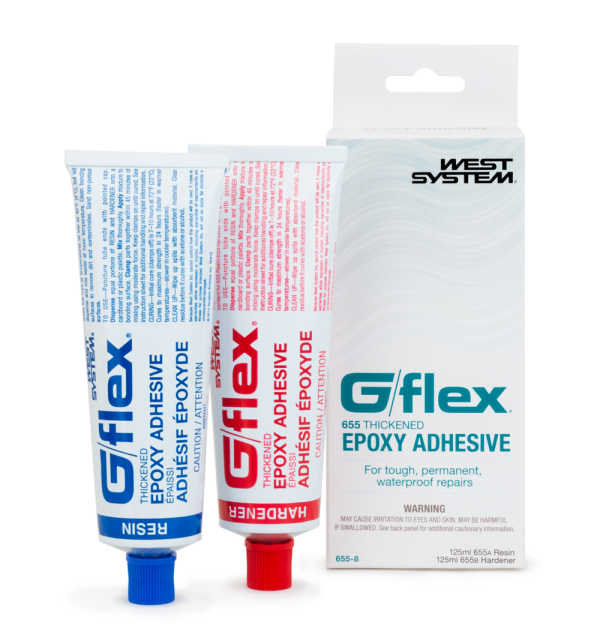Adhesion
The fundamentals of achieving strong secondary bonds are the same whether the interatomic forces are understood or not. They include:
- Wet out the substrate. The epoxy must be able to flow and wet the surface. Surface contaminates can prevent this from happening.
- Let the epoxy cure in place. Clamps must remain in place and the joint can not be stressed until the epoxy cures.
- Use a high-strength epoxy. WEST SYSTEM® epoxy is a structural adhesive after it has cured.

Understanding Tensile Adhesion
Tensile stress on an adhesive is created when a load is applied perpendicular to the surface. The stress generated by the load may cause an adhesion failure that is much lower than the actual tensile strength of the glue. Tensile adhesion value is not the same as tensile strength. WEST SYSTEM epoxy is formulated to have high tensile strength for applications such as creating a strong fiberglass laminate, and high tensile adhesion to common substrates for strong bonds. WEST SYSTEM G/flex® is formulated to achieve the highest adhesion values.
Loads that result in pure tensile adhesion in the real world are rare. When a tensile load is applied to a structure it often causes the substrate to deflect. This deflection then creates peel stress and can dramatically lower the strength of the assembly. It is also rare to have all the components assembled in such a way that the load path is purely tensile. A slight off-axis load can induce significant peel stress.
We use a PATTI device to measure tensile adhesion. This device pulls on bonded studs perpendicular to the surface and measures the load required to pull them off.
The Pneumatic Adhesive Tension Testing Instrument, or PATTI device, uses compressed air to inflate a bladder that lifts a metal stud glued to a substrate. A gauge measures the tensile force required to break the bond.
Tensile Adhesion of G/Flex Epoxies
| Material | G/flex | Surface Prep/Conditions | Tensile Adhesion (psi) |
|---|---|---|---|
| G-10 high-density laminate | 650 | 80-grit sand / dry surface | 3459 |
| G-10 high-density laminate | 655 | 80-grit sand / wet surface | 2473 |
| 1018 steel | 650 | 80-grit sand / dry surface | 3562 |
| 1018 steel | 655 | 80-grit sand / wet surface | 1772 |
| Galvanized steel | 650 | 100-grit wet sand | 2562 |
| Galvanized steel | 655 | 100-grit wet sand | 2929 |
| Copper | 650 | 80-grit sand | 2334 |
| Copper | 655 | 80-grit sand | 2685 |
| Bronze | 650 | 80-grit sand | 2782 |
| Bronze | 650 | Scotch Brite™ pad sand | 2962 |
| Bronze | 655 | 80-grit sand | 2936 |
| 316 Stainless Steel | 655 | 80-grit sand | 2522 |
| ABS plastic | 655 | 80-grit sand | 1535 |
| ABS plastic | 655 | 80-grit sand, flame treat | 1813 |
| ABS plastic | 655 | Alcohol wipe, flame treat | 3288 |
| PVC | 655 | 80-grit sand | 1780 |
| PVC | 655 | 80-grit sand, flame treat | 1813 |
| PVC | 655 | Alcohol wipe, flame treat | 2081 |
| Polyethylene (HDPE) | 655 | 80-grit sand | 400 |
| Polyethylene (HDPE) | 655 | 80-grit sand, flame treat | 1890 |
| Polyethylene (HDPE) | 655 | Alcohol wipe, flame treat | 2312 |
| Polycarbonate (Lexan®) | 655 | 80-grit sand | 1870 |
| Ipe | 650 | 60-grit sand | 2134 |
| Ipe | 655 | Plane, isopropyl alcohol wipe x 3 | 2223 |
| Teak, vertical grain | 650 | 80-grit sand parallel to grain | 1413 |
| Teak, vertical grain | 655 | 80-grit sand parallel to grain | 1381 |
| Teak, vertical grain | 655 | 80-grit sand, alcohol wipe x 2 | 1503 |
| White oak, vertical grain | 650 | 80-grit sand | 1935 |
| White oak, vertical grain | 655 | 80-grit sand | 1780 |
| White oak, vertical grain | 655 | Alcohol wipe x 2 | 2212 |
| Purpleheart | 650 | 60-grit sand parallel to grain | 1731 |
Adhesive Selection
When selecting a WEST SYSTEM epoxy product for use as a bonding adhesive consider the following:
- Working Time
- Assembly Time
- Time required until clamps can be removed
- Cure time
We rarely see failures due to the strength of the epoxy. Problems are more likely to occur when the epoxy is allowed to cure too much before the parts are assembled, or the epoxy isn’t allowed to cure sufficiently before a load is applied. Our customers are successful when they select a WEST SYSTEM epoxy designated as a structural adhesive with the cure profile that best matches their process and working conditions. In addition, best practices include preparing the surface properly and achieving the appropriate bond line thickness.
When designing, building or repairing a structure that relies on bonded components for strength, please call our Technical Advisors at 866-937-8797. We would be glad to discuss your project with you. —All text excerpted from <ahref=”https://www.epoxyworks.com/index.php/bond-lines-adhesive-bonded-structures/”>Adhesive Bonded Structures by Jeff Wright, Epoxyworks 34
